Google Chrome is by far the most popular web browser in the world, but is it the safest one? NSS Labs took three browsers, Mozilla Firefox, Google Chrome, and Microsoft Edge and put them to a security test. Although Microsoft Explorer is more popular than the Edge, it was omitted from the test because Microsoft Edge is the future for the company, exclusively available for the Windows 10, while Internet Explorer isn’t currently at the focus of Microsoft.
The three browsers were used by NSS Labs to open 304 Socially Engineered Malware (SEM) and phishing web pages in order to show which one will block the largest percent of malware found.

Their results are a bit surprising with Microsoft Edge ending in the first place, blocking 99 percent of the malware pages. Google Chrome managed to block 85.8 percent of pages, while Mozilla Firefox blocked “just” 78.3 percent of malware-infested web pages.
The surprisingly high result Microsoft Edge managed to score comes from one exclusive feature of the said browser called “Smart Screen.”
Smart screen is a website filtering tool that was introduced with Microsoft Explorer 7 and was later implemented into the Edge browser. It shows users that the website they want to visit contains malware by displaying a bright red page, a feature that was implemented in all three browsers.
Microsoft Edge and Google Chrome also feature sandboxing feature. It basically breaks up browser’s components into separate fragments (tabs, windows, and plugins), disallowing malware to spread to other parts of the OS, practically quarantining the malware.
Mozilla Firefox and Google Chrome, on the other hand, have much better, and faster, automatic update system. Both browsers automatically install new security patches in the background and then activate them as soon as the user closes the browser.
Microsoft Edge has to wait for new Windows 10 updates in order to receive new security patches, a slower method. Users also have to restart the whole computer, not just the browser, in order for the updates to be implemented.
All three browsers have their own security browsing feature. Firefox has Private Browsing, Chrome features Incognito Mode, and Microsoft Edge comes with Private Browsing Mode. While all three offer private browsing, only Mozilla Firefox uses Tracking Protection, removing web trackers from web pages visited while Private Browsing was activated.
The Microsoft Edge is the best when it comes to blocking malware pages. Both Google Chrome and Mozilla Firefox offer a better way of getting new security updates, and Firefox offers the safest private browsing experience.
At the end, it all comes down do a personal preference. But, If you want for your browser to block all (or almost all) potentially dangerous webpages, the Microsoft Edge looks like the best choice.
Also check – Google Chrome vs. Safari – Which web browser is best for Mac
